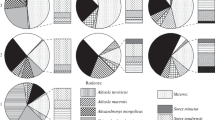Abstract
Quantitative and qualitative characteristics of nutrition of some cohabiting rodent species in the High-Mountain Zone of the Republic of Dagestan have been studied. The diet of S. uralensis consisted of 23, C. gud, of 22, M. arvalis, of 27, C. migtatorius, of 26, and D. nitedula, of 19 plant species. The most diverse diet was found in the common vole and gray hamster. In spring, sedges dominated in the diets of rodents, in the summer, rations consisted mainly of cereals, and autumn, predominantly from the species of the forbs and legume groups. In all, except for the forest dormouse, the conjugation of diets with the structure of herbaceous vegetation was revealed. The maximum values of the degree of similarity of the diets of rodents were found in pairs of wood mouse – Gudaur vole, Gudaur vole – gray hamster, and common vole – gray hamster. As a result, a sufficient level of food supply, a wide range of microstations, and intrapopulation adaptation mechanisms make it possible for the considered rodent species to live together in the study area.
Similar content being viewed by others
REFERENCES
Abaturov, B.D., Mlekopitayushchie kak komponent ekosistem (na primere rastitel’noyadnykh mlekopitayushchikh v polupustyne) (Mammals as the Ecosystem Component by Example of Herbivorous Mammals in Semidesert), Moscow: Nauka, 1984.
Sheremet’ev, I.S., Rozenfel’d, S.B., Dmitriev, I.A., et al., Food resource partitioning among the large herbivores of eastern Mongolia in summer, Contemp. Probl. Ecol., 2014, vol. 7, pp. 579–586.
Magomedov, M.-R.D., Dependence of feeding and the state of jerboa (Dipodidae) populations on the dynamics of forage resources, Zh. Obshch. Biol., 1989, vol. 50, no. 6, pp. 824–834.
Magomedov, M.Sh., An analysis of rodent feeding in the foothill zone of the republic of Daghestan: A microhistological cuticular-coprological method, Zool. Zh., 2017, vol. 96, no. 5, pp. 581–588.
Shvarts, S.S., Evolution and the biosphere, Problemy biogeotsenologii (Problems of Biogeocenology), Moscow: Nauka, 1973, pp. 213–228.
Bashenina, N.V., Puti adaptatsii myshevidnykh gryzunov (Ways of Adaptations of Mouse-Like Rodents), Moscow: Nauka, 1977.
Wynne-Edwards, V.C., Animal Dispersion in Relation to Social Behavior, Edinburgh: Oliver & Boyd, 1962.
Akaev, B.A., Relief, Fizicheskaya geografiya Dagestana (Physical Geography of Dagestan), Makhachkala: Shkola, 1996, pp. 112–150.
Lepekhina, A.A., Vegetation, Fizicheskaya geografiya Dagestana (Physical Geography of Dagestan), Makhachkala: Shkola, 1996, pp. 267–314.
Voronov, A.G., Geobotanika (Geobotany), Moscow: Vysshaya Shkola, 1973.
Hurlbert, S.H., The Measurement of niche overlap and some relatives, Ecology, 1978, vol. 59, no. 1, pp. 67–77.
Pianka, E.R., The structure of lizard communities, Annu. Rev. Ecol. Syst., 1973, no. 4, pp. 53–74.
Pianka, E.R., Evolutionary Ecology, New York: Harper and Row, 1978.
Bukvareva, E.N. and Aleshenko, G.M., Is niche division a condition or a consequence of the observed species diversity? Diversity optimization as an additional mechanism for forming the structure of ecological communities, Usp. Sovrem. Biol., 2012, vol. 132, no. 4, pp. 337–353.
Severtsov, A.S., The ratio of fundamental and realized ecological niches, Zh. Obshch. Biol., 2012, vol. 73, no. 5, pp. 323–333.
Hubbell, S.P., Neutral theory in community ecology and the hypothesis of functional equivalence, Funct. Ecol., 2005, vol. 19, no. 1, pp. 166–172.
Clark, J.S., Beyond neutral science, Trends Ecol. Evol., 2009, vol. 24, pp. 8–15.
Larionov, K.O., Nutrition and food supply of Saiga tatarica depending on the characteristics of vegetation on pastures, Extended Abstract of Cand. Sci. (Biol.) Dissertation, Moscow: Inst. Probl. Ekol. Evol. im. A.N. Severtsova, 2008.
Magomedov, M.-R.D. and Magomedov, M.Sh., Comparative assessment of the feeding intensity of the forest dormouse (Dryomys nitedula, Dryomys, Rodentia) and the yellow necked field mouse (Apodemus flavipectus, Murinae, Rodentia) in connection with the peculiarities of their seasonal activity, Zool. Zh., 2008, vol. 87, no. 6, pp. 748–753.
Abaturov, B.D. and Dzhapova, R.R., Forage availability to saigas (Saiga tatarica) and their state on steppe pastures with a different ratio of graminoid plants and forbs, Biol. Bull., 2015, vol. 42, pp. 163–170.
Chew, R.M. and Chew, A.E., Energy relationships of the mammals of a desert shrub (Larrea tridentata) community, Ecol. Monogr., 1970, no. 40, pp. 1–21.
Soholt, L.T., Consumption of primary production by a population of kangaroo rats (Dipodomys merriami) in the Mojave Desert, Ecol. Monogr., 1973, no. 43, pp. 357–376.
Perrin, M.R. and Boyer, D.C., The effect of rodents on plant recruitment and production in the dune fields of the Namib Desert, Trop. Zool., 1994, vol. 7, no. 2, pp. 299–308.
Zlotin, R.I. and Khodashova, K.S., Rol’ zhivotnykh v biologicheskom krugovorote lesostepnykh ekosistem (The Role of Animals in the Biological Cycle of Forest-Steppe Ecosystems), Moscow: Nauka, 1974.
Magomedov, M.-R.D. and Yarovenko, Yu.A., Feeding intensity and feed digestibility in dagestan tur (Capra cylindricornis Blyth) in captivity, Zool. Zh., 1997, vol. 76, no. 2, pp. 243–251.
Connell, J.H., Diversity and the coevolution of competitors, or the ghost of competition past, Oikos, 1980, no. 35, pp. 131–138.
Lack, D., Ecological Isolation in Birds, Oxford: Blackwell, 1971.
ACKNOWLEDGMENTS
The authors are grateful to Ph.D. R.A. Murtazaliev for help in determining the plant material.
Funding
The work was financed from the funds of the Caspian Institute of Biological Resources, Dagestan Federal Research Center, Russian Academy of Sciences.
Author information
Authors and Affiliations
Corresponding author
Ethics declarations
Conflict of interest. The authors declare that have no conflicts of interest.
Statement on the welfare of animals. All applicable international, national, and/or institutional guidelines for the care and use of animals were followed.
Rights and permissions
About this article
Cite this article
Magomedov, M.S., Magomedova, M. Distribution of Trophic Resources in a Rodent Community in the High-Mountain Zone of the Republic of Dagestan. Russ J Ecol 54, 331–337 (2023). https://doi.org/10.1134/S1067413623040069
Received:
Revised:
Accepted:
Published:
Issue Date:
DOI: https://doi.org/10.1134/S1067413623040069




